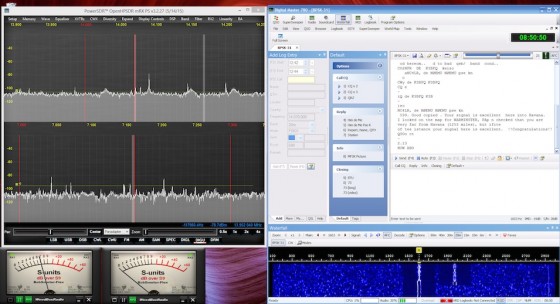The NR2 feature can often improve a weak noisy signal, so that it is usable. Plus there are also other useful tools for reception improvement such as Noise Blanker, Automatic Notch Filter, Preamp settings, and others. There are also some reception aids that are specific to CW. Another great reception tool is the ability to have three separate antennas connect to the back panel of the Anan 10E. Each band can be assigned to a given band and will be automatically switched in line when that band is chosen. The connected antennas can also be paired to allow you to use one antenna for receive and a different antenna for transmit for each HF band. This would also allow you to use up to three tuned antennas for each band you want to transmit on. The proper antenna will be selected by PowerSDR_mRX when you switch bands according to your configuration. If you are going to use a single antenna for multiple bands on transmit, you may need an external antenna tuner since there is not one built into the Anan 10E.
So in a nutshell, the Anan 10E is a very versatile and extremely competent receiver. Going out on a limb here, it may just be one of the best currently available competing with legacy radios two or three times more expensive. For you that like numbers, you might want to take a look at the test reports that AB4OJ ran on the Anan 100D and 200D. Although the Anan 10E is not exactly the same specs of the Anan 100D, they are somewhat similar in many ways. So take these numbers with a “grain of salt” in regards to the Anan 10E. However, after looking at several reviews reviews of the Anan series of SDR’s, it appears that most users have been very pleased with the receiver capability of the Anans.
But wait there is more!
The Second Receiver

The Anan 10E offers a second fully independent 0-55MHz receiver supported by PowerSDR_mRX and cuSDR. This second receiver can be used in a few different ways:
Monitoring a second band
PowerSDR has always offered the capability of using two independent VFOs that will allow you to monitor two different frequencies for receive or transmit within the bandwidth of the SDR transceiver. However, this was limited to the band the receiver was tuned to. With the Anan 10E, PowerSDR_mRX supports the use of the Anan’s second full range receiver with it’s own independent display and controls. The audio from the second receiver can be monitored and controlled independently along with the audio from the main receiver. This would allow you to be able to work contacts on say 40 meters while monitoring for activity in 10M. You could also use it to monitor PSK31 signals on 20M, while listening on 6M for DX. The second receiver adds a lot of flexibility to the Anan 10E for whatever you can dream up. cuSDR also offers this capability along with a full range realtime spectrum display.

Reduction of ADC # of bits by 2 reduces dynamic range by 1S unit ( -6dB)!
I wonder how one copes with this with respect to settings of gain distribution according to K3NA excellent recommendations ( google)!
Pierre,
F3WT
The 14-bit LTC2208 has a noise floor of -77.1 dBFS versus -78 for the 16-bit part. The SFDER is 98 dB versus 100 dB. I think the difference in *effective* number of bits is less than 1. The Perseus uses the 14-bit part and its performance is extremely close to that of designs using the 16-bit part.
Now, has anyone actually *measured* the performance difference in receive between the ANAN-10 and the ANAN-10E? Apart from advertising claims and some hand waving, I have seen no actual measured data published.
Thanks!
73,
Lyle KK7P
the calculation is not correct: 2 bits less cause a nominal degration of DR of 2 x 6.02dB = 12.04 dB! But we have to consider the ENOB ( effective number of bits)defined for each ADC and there difference is not so significant. We measured approx. 4 dB reduction
I have both the 10E and the 100D. Since I am a low band operator (160m primarily) the 100D is AWESOME!. With narrow filters and the NB2 noise reduction I can even use my transmit antenna and copy very weak signals. I have used both the 10E and 100D on an A/B comparison and the difference is barely noticeable. There is a new model about to be released and if the software can keep up with the new hardware the Flex users will soon be Apache Labs followers.